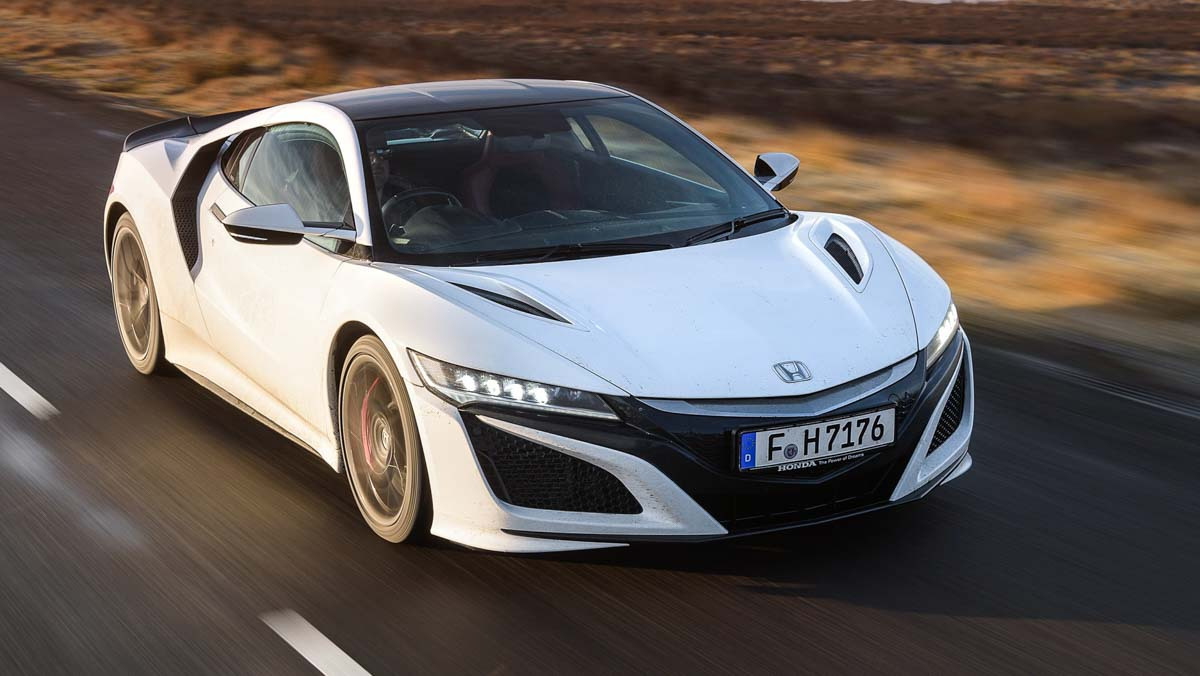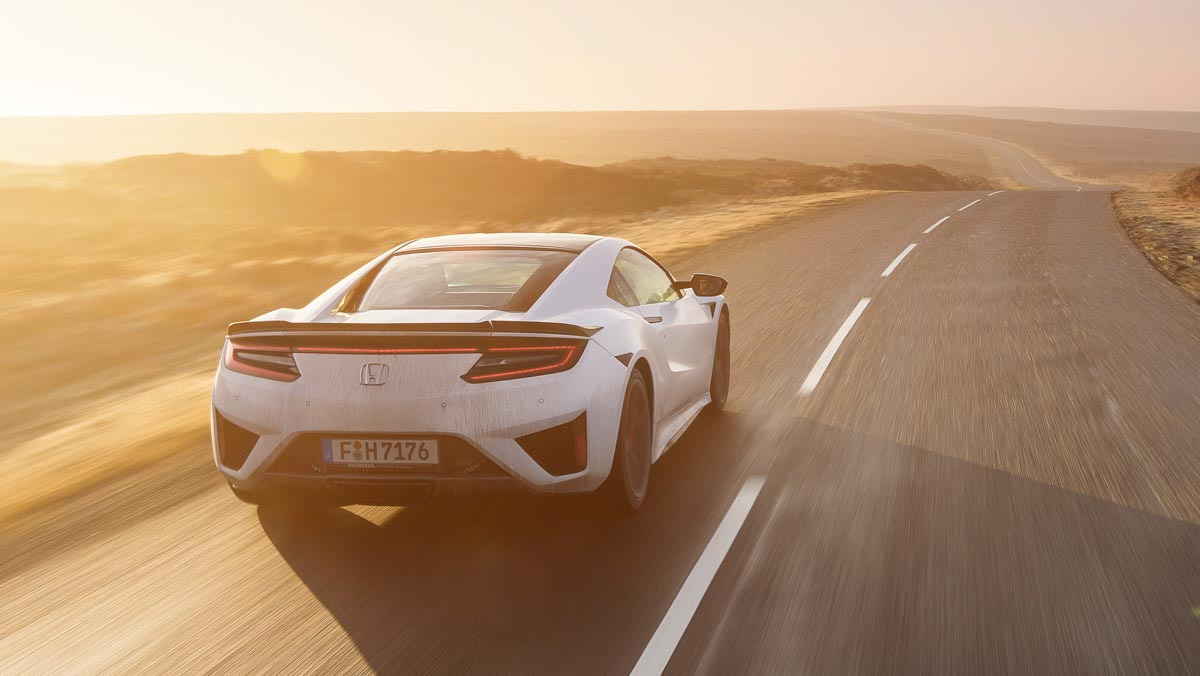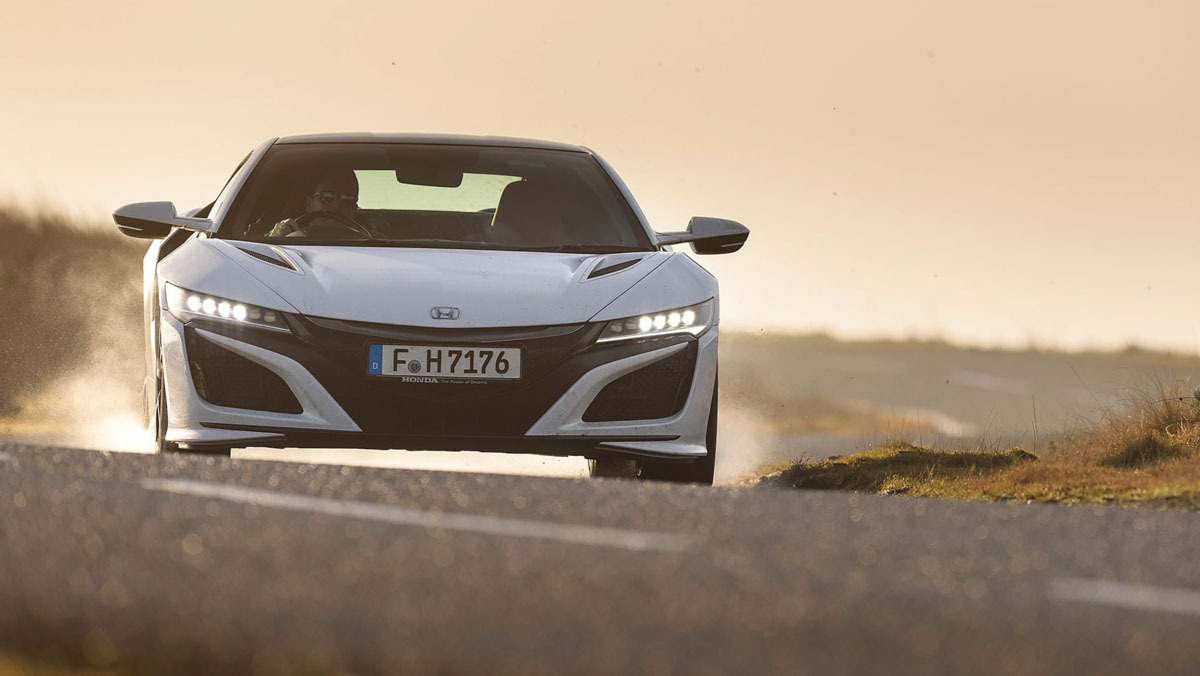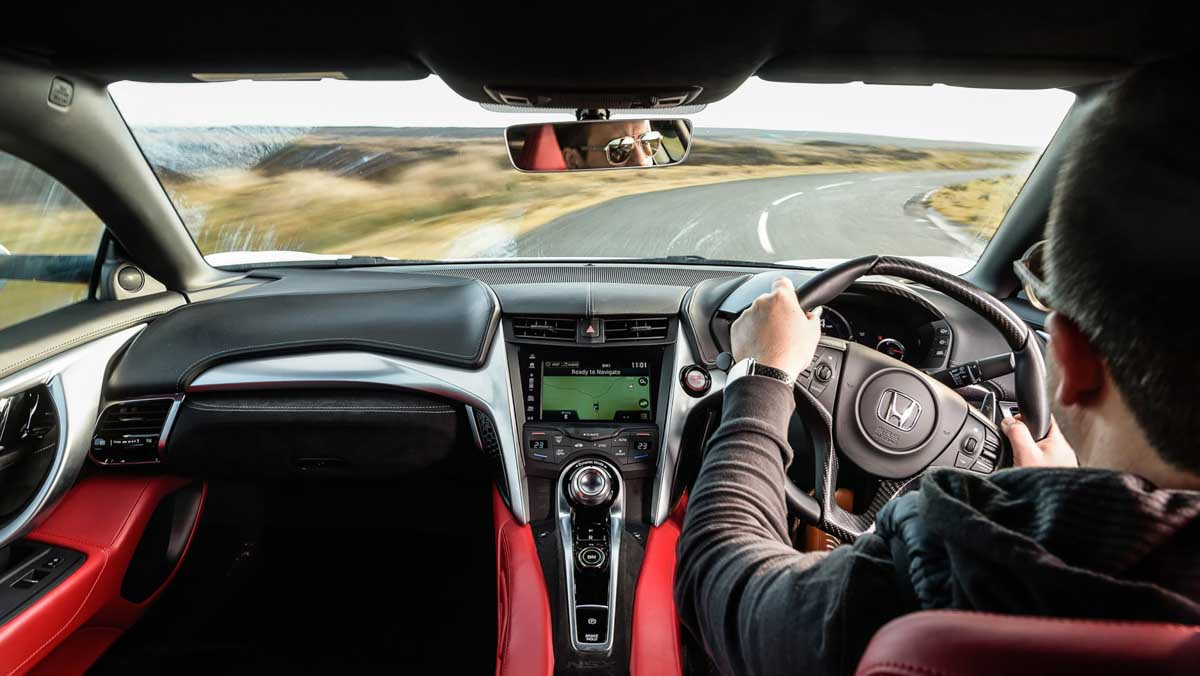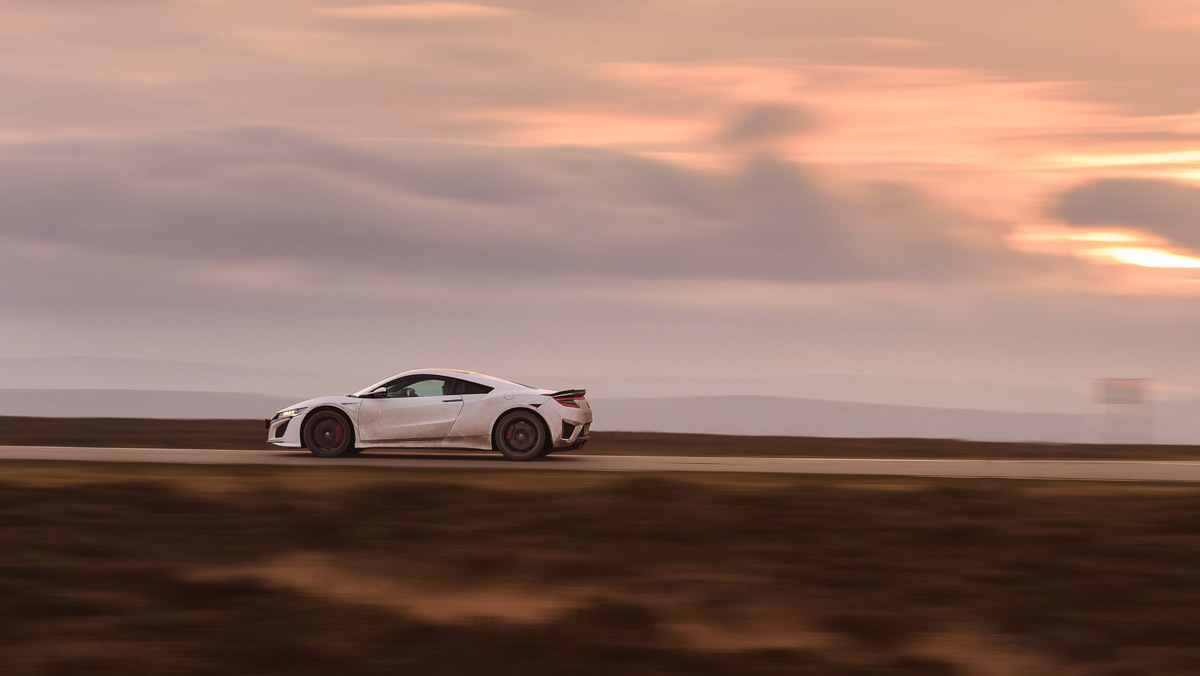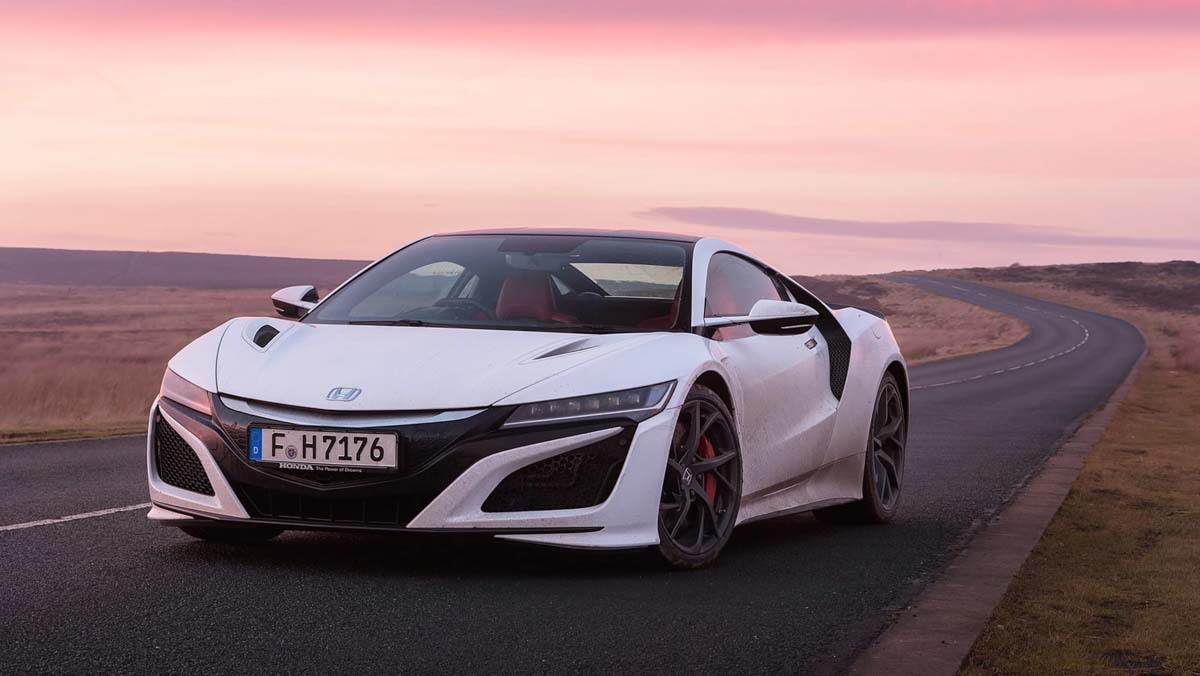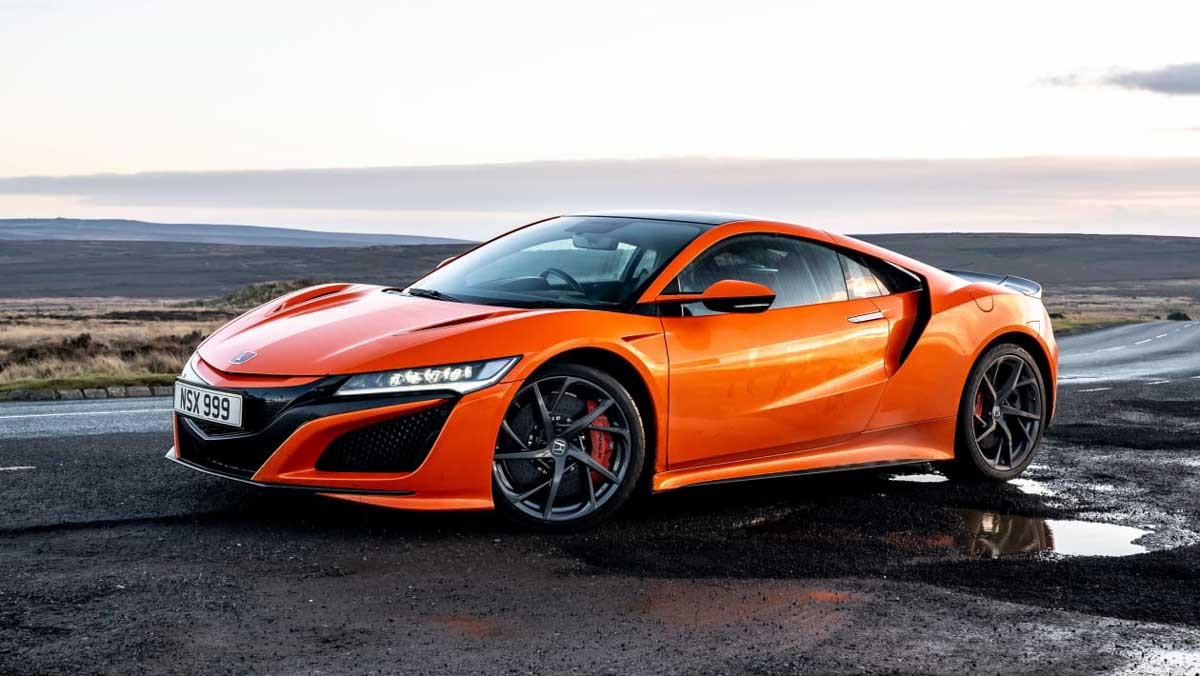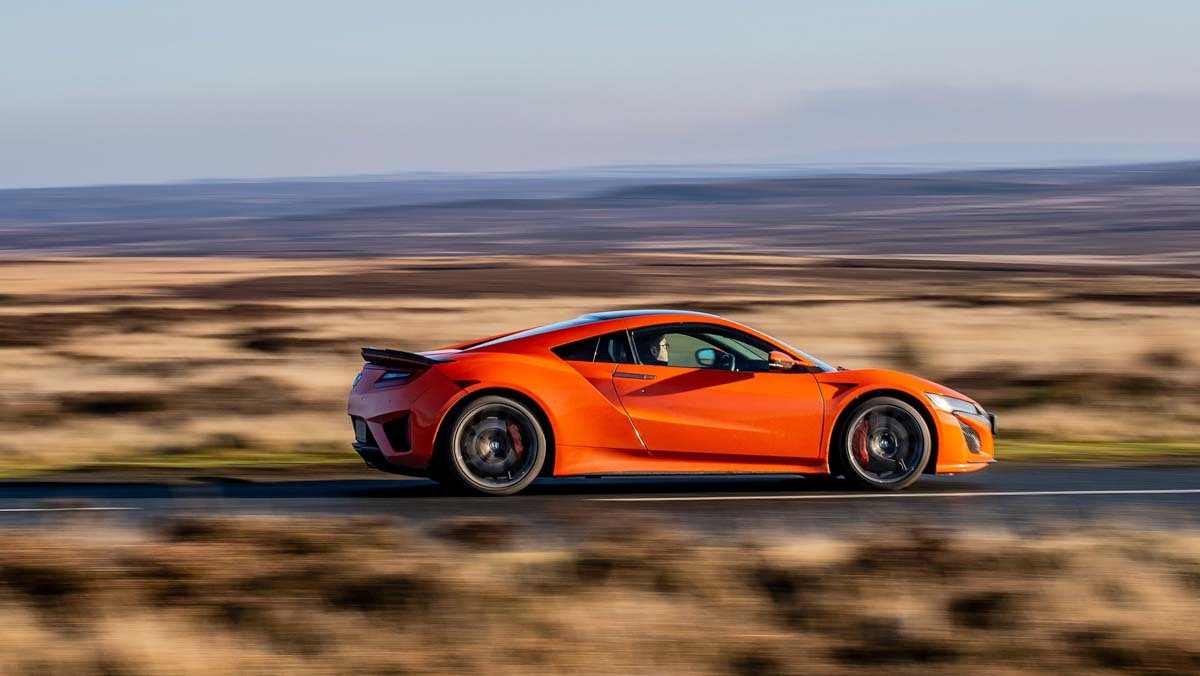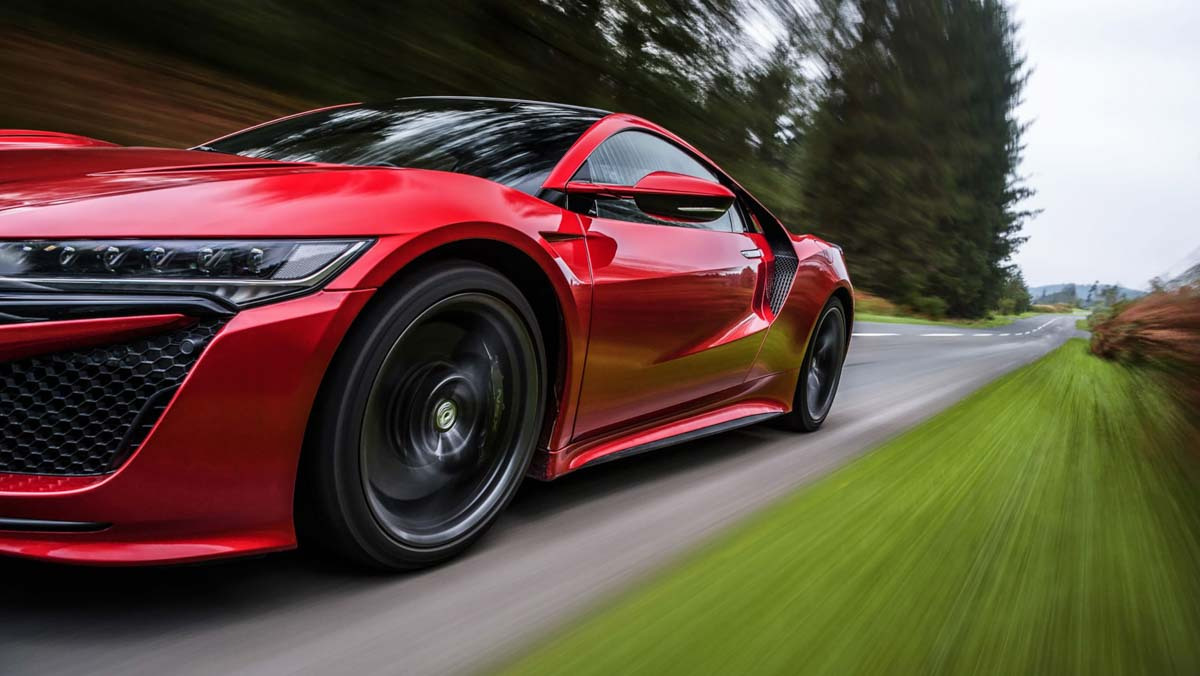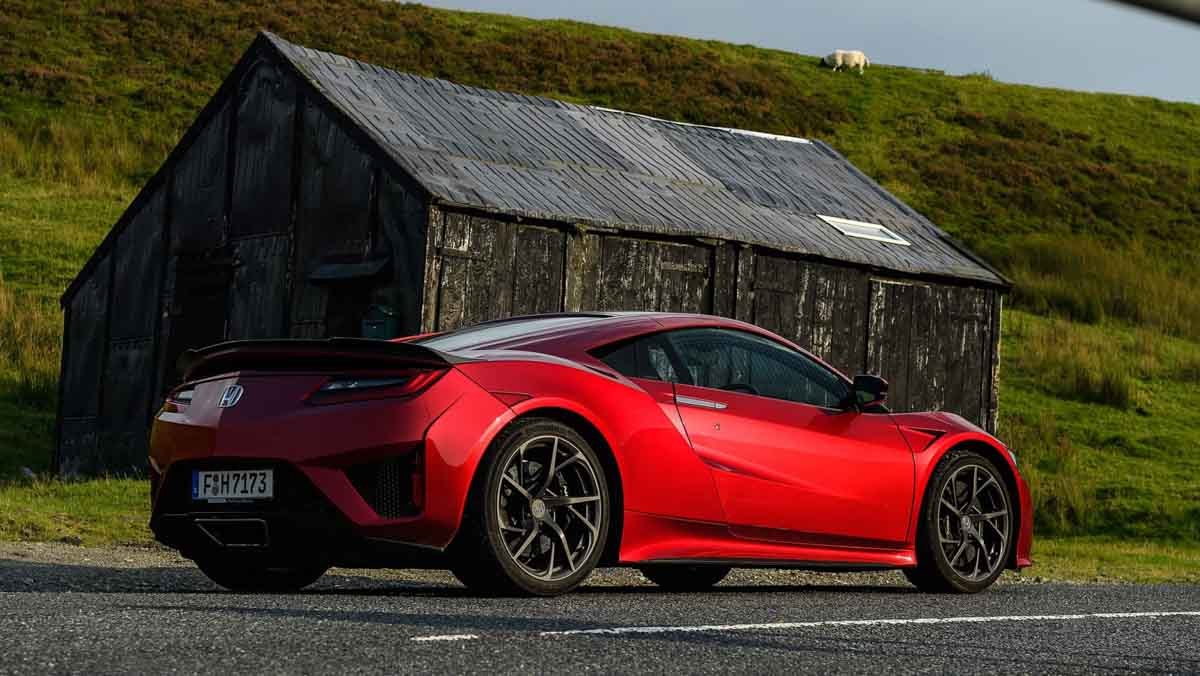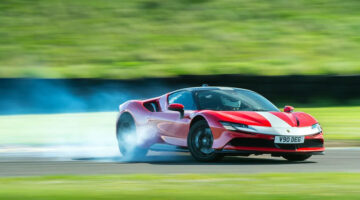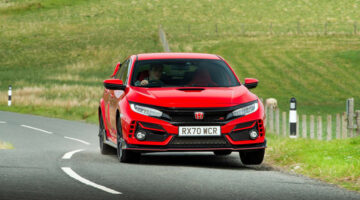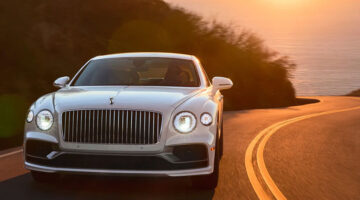The NSX melds technology and tactility to impressive effect, but still lacks the ultimate emotional appeal of the best supercars
| Beautifully integrated drivetrain and surprisingly engaging dynamics | |
| It lacks the ultimate focus and character of established supercar elite |
PRICE from $206,795
The $200,000 Honda NSX hybrid supercar is actually quite hard to pin down. In essence it is a bit like a mini Porsche 918 Spyder with its combination of a petrol engine, electric motors and four-wheel drive. Rather than the Porsche’s 4.5-litre naturally aspirated V8, the NSX has a twin-turbocharged 3.5-litre V6.
We almost became inured to the look of the new NSX having seen it on so many motor show stands over the last few years. But although it can appear a little fussy at standstill, it looks superb in motion and the impact of the wide, angular rear is terrific, helped at night by lights that stretch the full width of the car.
On the move the Honda is almost as exciting to drive as it is to look at, although it’s not without its quirks. Arguably the coolest is the ‘Quiet’ mode, which allows you to run in zero tailpipe emissions electric mode. You can’t go all that far (this isn’t a plug-in model, the so the batteries can only store enough charge for shortish, low speed squirts), but it’s somehow thrilling being able to slip around town in hushed silence. The rest of the time the motors operate to deliver McLaren P1 style torque-fill, gifting the Honda with, ahem, electrifying acceleration. With instant response and four-wheel drive traction the NSX fires down the road with real violence, although the neck-straining urge tails off a little as you stray deep into three figure speeds.
All this complexity comes with an unsurprising weight penalty, yet despite its not inconsiderable mass the NSX handles with agility and poise, helped in no small part by those electric motors, which enable power torque vectoring, tucking in the nose and delivering an extra dose of torque to the rear axle for genuine throttle adjustability. It’s just a shame the quick steering is rather lifeless. When you’re not driving with indecent haste the Honda is as refined, easy-going and, eye-swivelling dash layout aside, as simple to live with as a Civic.
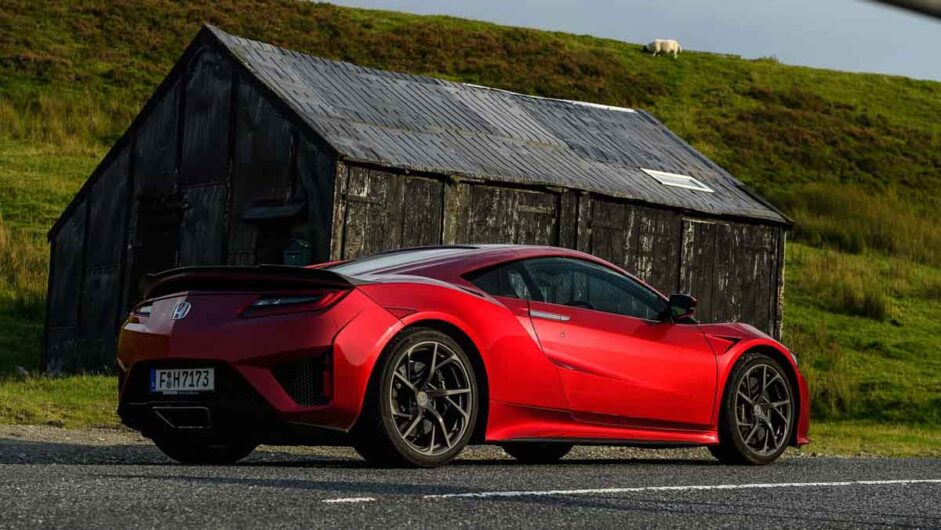
Prices, specs and rivals:
The naturally aspirated trio of the Porsche 911 991.1, first generation Audi R8 V10 Plus and Ferrari’s 458 provided the benchmark for the second coming of the NSX. These cars represented the supercar establishment during the NSX’s development, but since then the McLaren 540C, 992-generation Porsche 911 Turbo and Audi R8 V10 Plus have upped the ante in this fiercely contested segment.
The Audi R8 V10 Plus occupies the same financial bracket and sticks to the old naturally aspirated school of thought – the last model still doing so in the mainstream supercar arena. The NSX suffers over a 30bhp deficit to the R8, but boasts significantly more twisting power with 476lb ft of torque compared to the R8’s 413lb ft.
The Honda flagship also has competition from McLaren’s entry-level 540C, in essence a cheaper 570S. Retaining all the granular tactility of the 570S, but with a little less outright go (although you’d struggle to tell on the road, where it delivers the same laggy whizz-bang power delivery of the more expensive version). The Woking-based supercar may drop a few car lengths to the NSX when both are driven in anger, but it is the more engaging to drive of the two.
Opt for the non-S Porsche 911 Turbo and you’ll pay $185,350, though the $215,100 Turbo S falls squarely into NSX territory. Little more needs to be said of the 911 Turbo’s phenomenal point-to-point pace, which exists within the practical 911 package that can even accommodate a pair of (toddler-sized) passengers in the second row – a unique feature amongst these rivals.
The now-discontinued BMW i8 was the NSX’s closest rival in terms of technical anatomy. A single electric motor deploys power at the front axle to supplement the 1.5-litre petrol unit driving the rear; the combined output of the hybrid powertrain is 357bhp. The BMW i8 though, operates on a lower, sports performance plain rather than supercar echelon within which the NSX competes.
Performance and 0-100kph time
This is arguably one of the best-integrated petrol-electric hybrid systems out there, seamlessly blending both power sources to deliver a knockout punch. As you’d expect, the electric motors do their best work at low speeds, both boosting the low-rev torque of the twin-turbo V6 and delivering tenacious four-wheel drive traction. It’s low to medium speeds that the Honda is most impressive, firing out of slower corners with a controlled violence that borders on breathtaking. As speeds build and the trio of electric motors’ influence wanes the NSX feels quick, but not as rabidly so as, say, a McLaren 540C or Audi R8 V10, which is just getting into its stride as Honda’s urge begins to tail off.
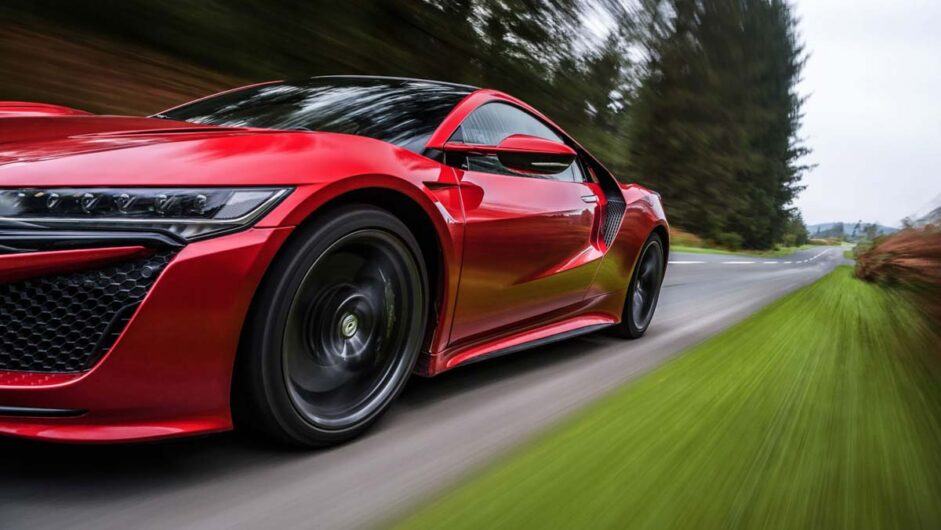
We carried out a launch control in the NSX, which was unflustered and pretty effective. You simply select Track mode, push hard on the brake pedal, floor the throttle, watch the revs build to about 2200rpm at which point a message will appear in the dials and you release the brake pedal.
Honda claims a 0-100kph time of 3.3 seconds, which is six tenths shy of big hitters such as the 911 Turbo S and the R8 V10 (our figure to 96kph was 2.9 seconds), but it’s hardly a slouch. In fact, when we strapped on our timing gear we recorded 3.3 seconds to 96kph, so Honda can’t be accused of being generous with the truth. The electric motors create impressive initial thrust off the line, there is then a very slight drop in the shove as the 3.5-litre V6 takes over before normal service is resumed and the combined forces propel you all the way to as much as 307kph.
Engine and gearbox
Providing the bulk of the power is that twin-turbo V6, which puts out 500bhp between 6500 and 7500rpm and 406lb ft of torque between 2000 and 6000rpm. In addition to this is a direct drive electric motor situated between the engine and the nine-speed dual clutch transmission.
The electric motor generates an additional 47bhp at 3000rpm and 109lb ft between 500 and 2000rpm. Finally there is also a Twin Motor Unit on the front axle, each of these motors puts out 36bhp at 4000rpm and 54lb ft between 0 and 2000rpm. The maximum outputs (obviously not arrived at simply by adding up all the individual maximums) are 573bhp and 476lb ft. As with almost all hybrid systems the Honda can run on electricity or petrol alone, or a combination of the two, something it does to impressive effect at low speeds, the motors adding extra muscle to the internal combustion engine. Where the NSX gets really clever is in its use of forward pair of motors for torque vectoring duty.
Let’s begin with Quiet mode, which you can either view as a boring very un-supercar sort of mode or quite a cool stealthy ninja method of slipping along unnoticed. Like the Porsche’s 918, the Honda can slide silently off a driveway early in the morning without waking the household. The engine will kick into life, but, as you’d expect, only quietly.
> McLaren P1 – review, history, prices and specs
Sport is next up and feels like a rather redundant mode. It’s a sort of everyday driving mode, but with an engine that sounds really quite unpleasant. Not loud, just lacking in any musicality. Better, to jump straight to Sport+ if you want a bit more urgency.
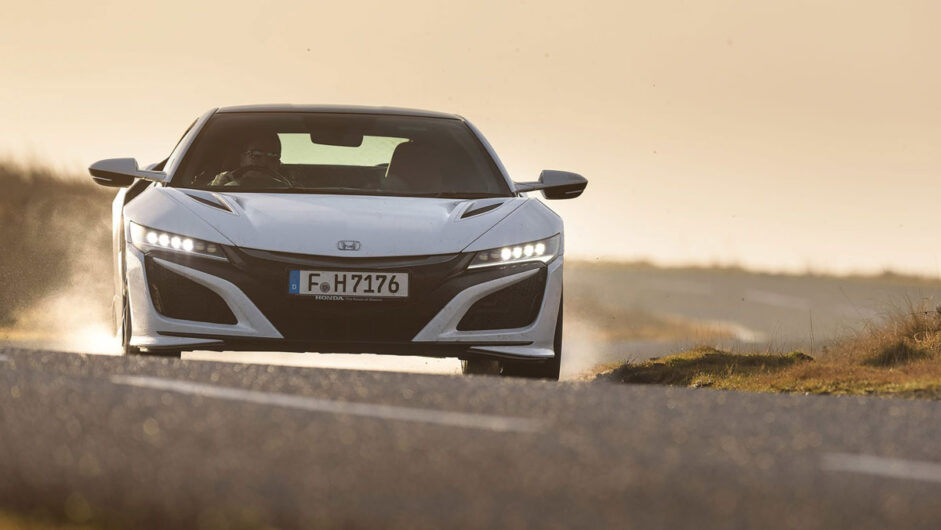
The engine is much more vocal, with more sounds of turbocharging but needs to be above 4000rpm to achieve a soundtrack worthy of a sportscar. Once up there it sounds really rather good though, with the hollow induction bark being channeled into the cockpit via some piping behind you.
The nine-speed DCT ‘box is impressive when left to its own devices. When you take control via the paddles, it is quite easy to run into the rev-limiter at 7500rpm and I found that you frequently had to make one last extra downchange on the way into corners to ensure you were in a low enough gear. Most automatics and double-clutch transmissions aren’t calibrated to change down sufficiently before a corner, or hold onto gears for long enough when driving enthusiastically or on track. The NSX, however, responds exactly how you would want it to, always being in the gear you’d naturally select anyway.
Ride and handling
On the road the NSX feels incredibly capable but also extremely composed. Speed, and lots of it, is easy to find and easy to carry through corners. But it’s the way it exits corners that is most remarkable; the torque vectoring and electric motors on the front axle mean you can be on the power exceptionally early without any loss of traction or worry you won’t stay on your desired line.
The steering wheel is a similar size and shape to a Ferrari F8 Tributo’s and the idea is that you shouldn’t have to move your hands from the quarter to three position. The rack obviously has to be quick enough to allow this and it is, although it has none of the nervous or twitchy feelings that you can get with Ferraris.
The wheel does have some feel through the electric power-assistance too and it talks to you at low speeds, which is good, but strangely it’s not a very mechanical feeling helm. In fact the NSX goes about the business of going quickly with, seemingly, very little involvement from the driver. No sort of adjustment or correction is ever needed; you don’t even feel what the drivetrain is doing other than the exceptional speed it has helped generate.
It takes a lot before you start to feel on top of the NSX; a lot of speed and a lot of commitment. It feels so unshakeable, even at such high speeds, you begin to fear how it might react if you did ever reach its limits. As you edge closer and closer to the extremes of the NSX’s abilities you do begin to feel what its clever four-wheel drive system is doing. You also start to feel the NSX’s mass and you can begin to use that to manipulate it around corners; you feel the rear axle go light as you trail brake heavily into tight corners, the car then rotating towards the apex.
The nose will begin to push wide when you do start nudging the very high limits of grip, but it feels perfectly natural to lean on this very mild slip, working with it all the way through a long corner until you feel confident getting hard on the throttle as the bend opens out. At which point the balance will switch nicely to the rear. The NSX feels much the same on the track as it does on the road, but the space and freedom allows you more opportunities to appreciate how it feels at the edge of its limits.
Perhaps the most impressive thing, however, and something that sums up the new NSX is the braking. It is fly-by-wire and has to meld the wonders of regenerative braking with the more conventional forces of pads on carbon discs. Instinctively I was mistrustful of the idea of the brake pedal being attached to a switch, but if you didn’t know you wouldn’t guess. Full of power and easily modulated, the brakes just felt very natural. And it’s really the same for the rest of the car, because despite all the technological wizardry it is harnessing, the NSX feels quite natural and intuitive to drive.
L/100km and running costs
The old adage about not buying a supercar if you’re worried about running costs doesn’t apply in full to the NSX, especially if you ignore its $206,795 list price (not that you’ll do that in a hurry). By utilising its hybrid running gear effect both low speed all-electric running and as a useful start-stop system the Honda claims a not unreasonable 10L/100km at the pumps – not bad for near 600bhp supercar weighing in at nearly 1800kg. That said, in everyday use you can expect low to mid-twenties, while giving the Honda its head will see superunleaded downed at the rate of a gallon every 25 kilometers or so.
Still, CO2 emissions of 228g/km mean it’s a not unreasonable expensive car for business users, while being a Honda it’ll be as dependable as a Southern Train services is unreliable.
Interior and tech
At a glance the Honda’s interior is all a bit Dan Dare, an array of digital dials and numerous buttons make it more starship than car. It gets easier to navigate with time, but it’s never as straightforward as the cabin of a Porsche 911. Still, it’s dripping with kit, from the touchscreen sat-nav and infotainment (fabulously counter-intuitive), soft leather trim and the really rather good ELS nine-speaker hi-fi. Yet the NSX’s commitment to the ‘everyday supercar’ tag hasn’t been forgotten completely. For example, the A-pillars have been designed to be thinner and less obstructive than in other modern cars. Using a rectangular steel tube design called 3DQ, the width of the pillar is just 89mm, compared with a claimed standard width of 124mm. The interior surfaces of the cockpit have also been designed to give more support where you need it when driving hard, namely the areas where the outside of your knees/lower legs want to rest.
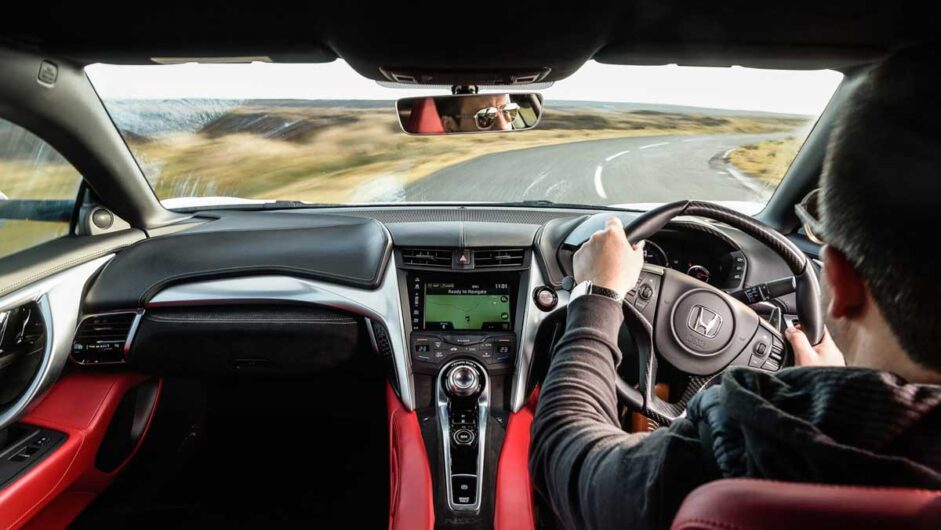
There’s also decent room for the driver and passenger, the former getting more than enough seat and wheel adjustment to able to sit ‘just so’. Less impressive is the luggage carrying capacity, the need to house batteries and extra motors limiting boot space to tight 110-litre load area in the nose.
Design
There’s not denying it, the NSX is something of a looker. While the original has gone down in history for its sublime handling and screaming motor, few will rate it’s ungainly looks – but that’s not the case here. All sharp curves, creases and hunkered stance, the American-styled NSX arguably wins its membership to the supercar club on styling alone.
It’s not just a pretty face either, because lots of attention has also been paid to the aerodynamics, in particular to reattachment of the airflow behind the front wheels. The aim of this is to better channel the air through the intakes by the C-pillars. At this point the air is split between flow into the intercoolers, flow across the top of the rear deck and a stream that emerges from a small slit above the rear lights. Crucially, unlike rivals such as the Porsche 911 Turbo the Honda doesn’t rely on active aerodynamics – there are no moving planes or switchable surfaces here.
> Aston Martin DB11 review – British GT shows poise and pace
Under the skin the construction of the car is not particularly advanced, with no carbonfibre to shout about. However, there is a world-first application of ablation cast aluminium. It has the stiffness of a normal casting and the ductility of a forging, which means the parts can be used as attachments points for the suspension while also acting in the front and rear crash structures.
Typically for a Honda, the front suspension uses a double wishbone set-up, but at the rear there’s a complicated multi-link arrangement. As well as third generation magnetic ride dampers, the NSX’s handling is helped by (deep breath) Sport Hybrid Super Handling All-Wheel Drive. The key component of this is the torque vectoring available using the twin motors at the front. The limited-slip differential on the rear axle is also brought into play to create something called Direct Yaw Control, which essentially helps make a heavy car (1725kg) feel much lighter and more nimble than it should. Steering is electrically assisted and utilises a variable ratio rack.
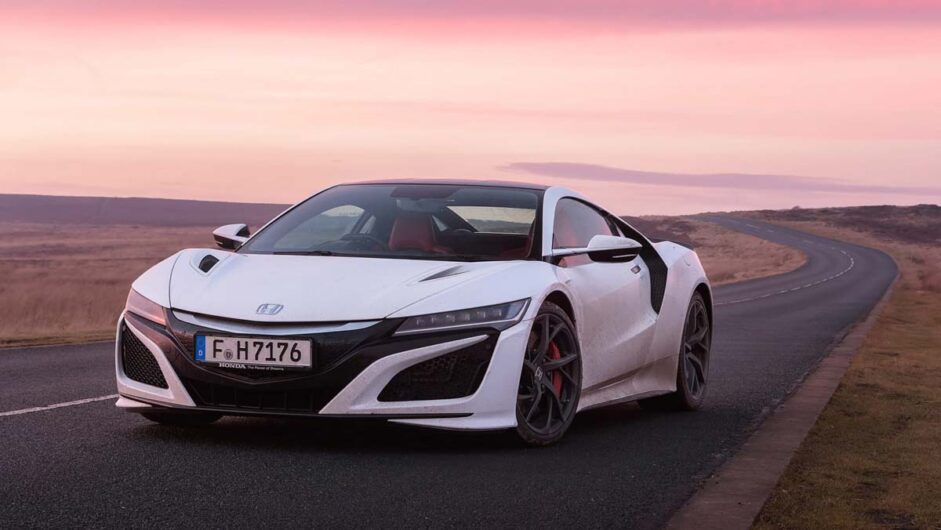
This article originally appeared at evo.co.uk
Copyright © evo UK, Dennis Publishing

